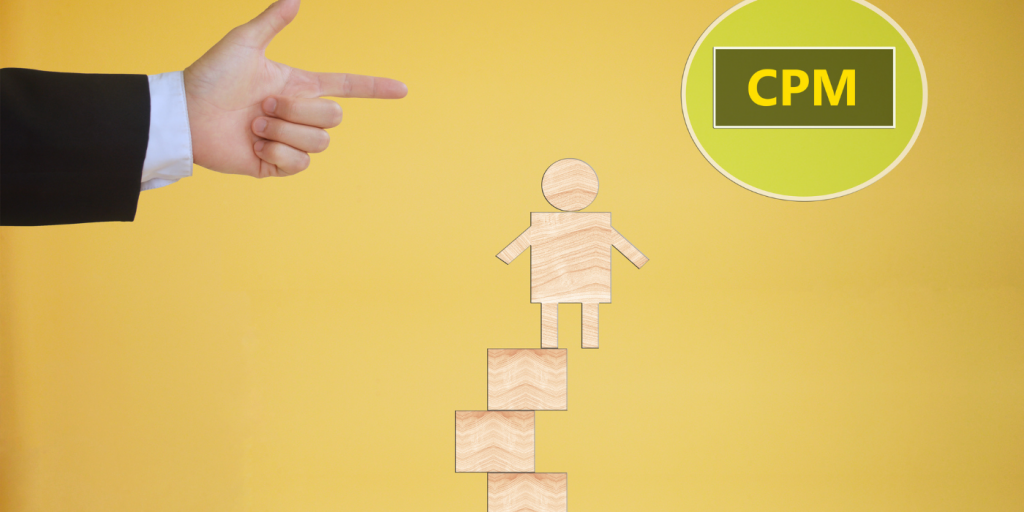To know how successful your ad campaigns have been, you must look at the revenue that has been generated through them. However, this is easier said than done. With all the confusing marketing terms and various revenue calculating models in use today, it is easy for an amateur to get lost in the jargon. If you have been trying to calculate the effectiveness of your display advertisements but cannot wrap your head around the tricky metrics, this article is for you.

When calculating the earnings made through digital advertising, the two most popular terms you will hear of are RPM and CPM. Though often used interchangeably by the digital media industry, they technically mean quite different things. Let’s take a closer look at each of these and try to unravel the mystery behind RPM and CPM.
What Is RPM And How To Calculate It?
RPM, or revenue per mille, is one of the most widely used metrics in the digital media industry to understand one’s earnings from display advertising campaigns. The ‘mille’ in revenue per mille stands for 1000 impressions.
Put simply, the RPM of your digital advertising campaign tells you the estimated revenue that has been generated from a thousand page views. A page view is a consumer visiting your website. It is important to note that a page view does not always end in one ad impression, but can result in multiple of them.
The RPM of an advertisement project can be calculated as follows:
RPM = (total earnings estimates / total number of page views) * 1000
Sounds complicated? Let’s make it easier to understand with an example.
Let’s say you are making $50,000 from 50,000,000 impressions on your ads. In this case, your RPM can be calculated as:
RPM = (total earnings estimates / total number of page views) * 1000
RPM = ($ 50,000 / 50,000,000) * 1000
RPM = $1.00
What Is CPM And How To Calculate It?

CPM stands for Cost Per Mille. Also known as cost per 1000 impressions, it is a calculation of the amount spent to get 1000 views (deliveries) of your digital advertisement. Whether that ad view generates revenue or not has no role to play in the CPM value. Even if a consumer sees an ad and scrolls down, it is still regarded as a legit view and goes towards the calculation of Cost Per Mille.
Just like RPM, CPM can also be calculated by using a simple formula:
CPM = (Cost of the campaign / Number of total impressions) * 1000
Need more clarity? Here’s an example of how this formula can be used to calculate CPM.
Let’s say that you are willing to spend $50,000 to run digital ads. So you decide to invest it into a CPM ad campaign and increase your visibility to the consumers. As a result, 50,000,000 new consumers came across the ad you ran – some of them approached you for business, and the others kept scrolling.
In such a scenario, the CPM of your ad campaign can be calculated as:
CPM = (Cost of the campaign / Number of total impressions) * 1000
CPM = ( $ 50,000 / 50,000,000 ) * 1000
CPM = $1.00
The Main Differences Between RPM And CPM – An Overview
If you are still confused between the RPM and CPM of your display advertisement project, don’t fret. In this section, we will take a closer look at the differences between the two and attempt to make a clear distinction between the two terms.
| RPM – Revenue Per Mille | CPM – Cost Per Mille |
| RPM is a publisher metric | CPM is an advertiser metric |
| RPM is usually higher than CPM | CPM is usually lower than RPM |
| RPM measures the cost based on pageviews and the number of ad units | CPM involves the measurement of the cost based on number of impressions per ad unit |
| RPM can be optimized by the publisher by various methods, such as creating multiple ad placements or testing different kinds of ad for the revenue they generate | Artificial Intelligence is used to determine the best target audience for a CPM campaign |
| RPM is most widely used by Google AdSense | CPM is most commonly used in real-time bidding |
What Factors Influence RPM And CPM?
There are three primary factors that influence RPM and CPM: traffic volume, advertising quality, and advertiser competition.
1. Traffic Volume
The amount of traffic that a website receives is directly proportional to the amount of money that a website can generate from advertising. More traffic means more potential ad views, which leads to more revenue.
2. Advertising Quality
The quality of the advertising on a website also has a direct impact on RPM and CPM. If the ads are well-targeted and relevant to the website’s audience, they will be more likely to be clicked on, which will generate higher revenue.
3. Advertiser Competition
The level of competition for ad space on a website will also affect RPM and CPM. If there are a lot of advertisers competing for space on a website, they will be willing to pay more for each ad view, which will drive up RPM and CPM.
RPM Vs. CPM – Which Is A Better Metric To Understand Your Ad Performance?
Now let’s return to our original concern. You want to see how successful the ad campaign that you’re running has proven itself to be. Which of these two metrics is a better reflection of the performance?
Looking at the RPM can help you get an idea of the money you have made from running an ad campaign. But if you start focusing solely on this, you run the risk of bringing down the quality – and hence viewability – of your advertisements. This is why you should be giving CPM its due attention as well.
Your CPM allows you to understand the quality of the advertisements you are putting out. The better the content of your ads, the greater the views you get on them. It can help you decide which of your advertisements are getting you more visibility and should be pushed further, and which advertisements have failed to achieve the same, and the ones you should retire.
Tips To Increase RPM And CPM
Here are a few tips that will help you boost your RPM and CPM.
1. Invest in quality content
If you want people to keep coming back to your site, you need to invest in high-quality content. This means hiring experienced writers and editors, and ensuring that all of your content is well researched and free of errors.
2. Increase your update frequency
Another way to keep people coming back to your site is by increasing the frequency of your updates. If you only update your site once a week, try increasing it to 2-3 times per week.
3. Create more targeted content
To attract more visitors, create content that is targeted toward specific niche markets. This could include creating articles, blog posts, or even infographics that are specifically relevant to your target audience.
4. Make use of social media
Use social media platforms like Twitter and Facebook to promote your content and drive traffic back to your site. By sharing links to your latest articles and blog posts, you can quickly increase the number of people who are aware of your site.
5. Use effective keywords
One of the most important aspects of increasing your RPM and CPM is to use effective keywords throughout your site. Keywords are the words and phrases that people use when searching for information online. By incorporating relevant keywords into your site’s content, you can make it more likely that people will find your site when they perform a search.
6. Incorporate audio and video content
In addition to traditional text-based content, more and more people are looking for audio and video content. If you can provide this type of content, you’ll be able to attract a wider audience.
7. Use attention-grabbing headlines
The headline of your article or blog post is often the first thing that people will see. As such, it’s important to make sure that your headlines are attention-grabbing and relevant to the rest of your content.
8. Create infographics and other visuals
Another way to make your content more engaging is to incorporate infographics and other visuals. People are generally more likely to remember information presented in a visual format, so this can be an effective way to increase the overall engagement of your site.
9. Make sure your website is user-friendly and mobile responsive
In today’s world, it’s important to make sure that your website is user-friendly and mobile responsive. If people have a hard time navigating your site or if it doesn’t look good on their phone, they’re likely to leave and never come back.
10. Offer something unique
There are millions of websites out there, so it’s important to make sure that your site offers something unique. This could be a unique perspective on current events, original research, or even just a different take on a popular topic.
Wrapping It Up
In a nutshell, both RPM and CPM deserve equal attention to keep your earnings up, and the consumer engaged. From a publisher’s standpoint, RPM is the metric of success. But from an advertiser’s standpoint, CPM is the metric that deserves more focus. However, both of these calculations are mere estimates and do not mirror the exact earnings from an ad campaign.